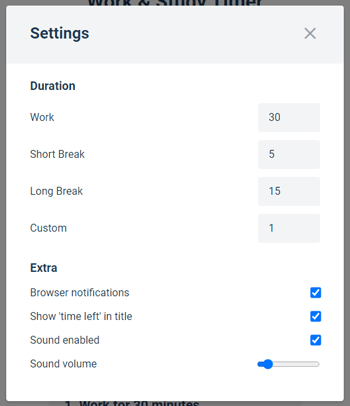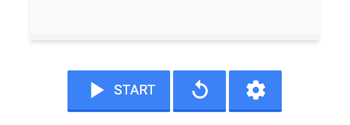Work & Study Timer
Save time and energy, boost your productivity
What is this timer?
This tool is a work timer and study timer you can use for, as the name tells, working and studying. Whether you're working from home, the office, school or any other spot, you can use this tool to make the most out of your day. It aids you in achieving flow state, while simultaneously taking proper breaks.
Working efficiently is hard
We humans feel differently every day. Some days we're motivated and ready to work, but other days we feel tired, not motivated, and we would rather relax and do nothing.
How can we make the most of our days? Through proper time and energy management.
This tool helps you build, and maintain, a healthy habit
This work timer provides you a structured way of building and maintaining a healthy habit: maintaining a healthy balance between working and taking breaks. The goal is to minimize feeling strained and tired during the middle of the day, or after work, by taking sufficient breaks and not depleting your mental and physical energy too quickly. It's better to keep your energy level high throughout the day, so that you're getting things done at the beginning and the end of the day.
How to use this Work Timer?
-
1. Select a timer mode
First, select a timer mode (see image). While there are default settings, 30 minutes for work, 15 for a long break, and 5 for a short break, you can change the settings to what suits you best.
![Time select buttons]()
-
2. Start the timer
Press the START button to start the timer. To pause the timer, press the PAUSE button. The timer shows the amount of time left. To reset and restart the timer, you can press the middle button with the 'replay' icon.
![Control buttons for study timer tool]()
-
3. The time is up
By default, once the timer finishes, it plays a sound to notify you, as well as showing a desktop notification. You can turn them both off in the settings.
Changing settings
To change settings, press the settings button (the rightmost button), a settings pop up opens up.
-
Duration
Under Duration you can set the durations of the various timer modes, in minutes. The options are Work, Short Break, Long Break and Custom. You can use the custom mode for special cases.
-
Extra
Under Extra you can turn the sound on or off, as well as change the sound volume. Next, you can toggle whether the tool should display the time left in the title of the website. This means you can see the time left when you're working in another browser tab. If it distracts you, you can turn it off. Finally you can also turn browser notifications on or off by clicking the check mark.

What should I do during the breaks?
Essentially you can do whatever you want. However, certain activities help you regain energy, relax and unwind better than others. Examples of healthy activities are socializing, moving around/taking a walk/exercising, meditating, eating some fruit. Of course there are numerous other examples of healthy break activities. Activities such as scrolling social media are generally seen as less effective.
How long should my sessions/breaks be?
This really depends on the cognitive load and the type of tasks you're working on. Certain tasks are cognitively taxing, and therefore we recommend you to take frequent breaks. However, at the same time, certain tasks work out better when you work for longer. For example when you're programming, it takes a while to get into the flow of the code and solving problems. With such activities, it is best to make the durations longer.
Other frequently seen options include:
- Work for 25 minutes, take 5 minute breaks, with a 15-30 minute break every 4th break
- Work for 40 minutes, take 8 minute breaks, with a 25-40 minute break every 4th break
- Work for 50 minutes, take 10 minute breaks, with a 30-45 minute break every 4th break
Note that you can adapt the work and break durations to what works best for you and suits the tasks you're working on. We recommend you to experiment with different options to find out what durations work best for you.
Tips
Make sure you detach yourself from your work during breaks. It's hard to relax sufficiently when you keep thinking about a problem you're facing in your work during your breaks, because it will keep your mind engaged and your brain keeps working, which costs energy. So thinking about work during breaks limits the positive effects of the break.

